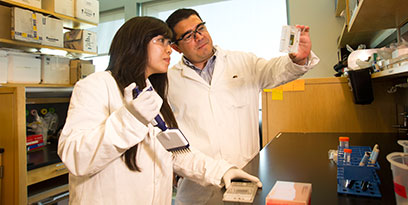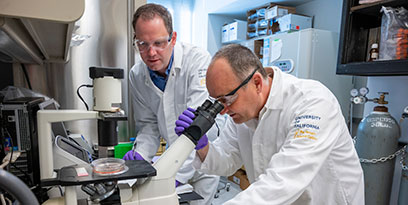Lin Tian, Ph.D.

WOS Adjunct Faculty
lintian@health.ucdavis.edu
Research Interests
The goal of our research is to invent new molecular tools for analyzing and engineering functional neural circuits. We also leverage these tools, combined with optical imaging techniques, to study molecular mechanisms of neurological disorders at system level and to empower searching for novel therapeutic treatments.
One of the primary challenges in neuroscience is to link complex neural phenomena to the structure and function of their composite neural circuits. Addressing this problem requires a thorough understanding of patterns of neural activity, and the ability to relate this to physiological processes, behavior and disease states. An essential step towards this goal is the simultaneous recording of neural activity in large, defined populations, ideally in intact circuitry. Traditional electrophysiological approaches provide excellent sensitivity and temporal resolution, but are limited in the number of cells that can be recorded simultaneously.
Fluorescent protein based biosensors can transfer changes in neural state (e.g. membrane potential or essential ion flux or enzyme activity) to fluorescence observables. They are genetically encoded, and can thus be used to label large populations of defined cell types and/or sub-cellular compartments. Combined with modern fluorescence imaging techniques, these probes allow us observe and track how neural networks are established or modified in time and space and find out what goes wrong in diseases. Our lab used a variety of techniques (computational protein engineering, rational design, molecular evolution, chemical synthesis) to develop genetically encoded imaging probes, such as calcium indicators, neurotransmitter sensors and kinase sensors. We also explore strategies for better targeting these sensors to small compartments in the nervous system, such as axon terminals, and for longer expression with reduced cytotoxicity in vivo.
Chemical probes are also essential tools in biology for measuring and manipulating cellular properties. Evan wit high molecular specificity, however, their application in complex biological environments is frequency limited by poor cellular specificity. Our previous research has demonstrated a straightforward approach for the identification of orthogonal ester-esterase pairs that are stable to endogenous esterase activity and can be directed to specific cell types. We will utilize different chemistries in future work to develop tissue-specific probes for drug or metabolite localization and activity in cells, tissues, or model organisms.
We also integrate our imaging probes to induced pluripotent stem cells (iPSCs)-derived neurons and glias to create a platform for studying psychiatric diseases in vitro. Such cultured human neuronal networks will enable us to visualize how the precise, guided communication in neurons develops, and how it breaks down in diseases. With this system we can test a library of drugs to identify ones that can correct the communications defects in a patient-specific manner; such a drug screening would not be possible on living patients.
My research program will provide interdisciplinary trainings for graduate students and postdoc fellows.
Graduate Group Affiliations
Vargas MV, Dunlap LE, Dong C, Carter SJ, Tombari RJ, Jami SA, Cameron LP, Patel SD, Hennessey JJ, Saeger HN, McCorvy JD, Gray JA, Tian L, Olson DE. "Psychedelics promote neuroplasticity through the activation of intracellular 5-HT2A receptors". Science. 2023 Feb 17;379(6633):700-706. doi: 10.1126/science.adf0435. Epub 2023 Feb 16. PMID: 36795823; PMCID: PMC10108900.
Jørgensen SH, Ejdrup AL, Lycas MD, Posselt LP, Madsen KL, Tian L, Dreyer JK, Herborg F, Sørensen AT, Gether U. "Behavioral encoding across timescales by region-specific dopamine dynamics". Proc Natl Acad Sci U S A. 2023 Feb 14;120(7):e2215230120. doi: 10.1073/pnas.2215230120. Epub 2023 Feb 7. PMID: 36749722; PMCID: PMC9963838.
Chunyang Dong, Yu Zheng, Kiran Long-Iyer, Emily C. Wright, Yulong Li, Lin Tian. “Fluorescence Imaging of Neural Activity, Neurochemical Dynamics, and Drug-Specific Receptor Conformation with Genetically Encoded Sensors” Annual Review of Neuroscience 2022 45:1
Munir Gunes Kutlu, Jennifer E. Zachry, Patrick R. Melugin, Stephanie A. Cajigas, Maxime F. Chevee, Shannon J. Kelly, Banu Kutlu, Lin Tian, Cody A. Siciliano, Erin S. Calipari, “Dopamine release in the nucleus accumbens core signals perceived saliency”, Current Biology, Volume 31, Issue 21, 2021.
Tjahjono N, Jin Y, Hsu A, Roukes M, Tian L. “Letting the little light of mind shine: Advances and future directions in neurochemical detection”. Neurosci Res. 2021 Nov 30:S0168-0102(21)00246-7. doi: 10.1016/j.neures.2021.11.012. Epub ahead of print. PMID: 34861294.
Abraham, A.D., Casello, S.M., Schattauer, S.S. et al. “Release of endogenous dynorphin opioids in the prefrontal cortex disrupts cognition”. Neuropsychopharmacol. 46, 2330–2339 (2021).
Bryan A. Copits, Raaj Gowrishankar, Patrick R. O’Neill, Jun-Nan Li, Kasey S. Girven, Judy J. Yoo, Xenia Meshik, Kyle E. Parker, Skylar M. Spangler, Abigail J. Elerding, Bobbie J. Brown, Sofia E. Shirley, Kelly K.L. Ma, Alexis M. Vasquez, M. Christine Stander, Vani Kalyanaraman, Sherri K. Vogt, Vijay K. Samineni, Tommaso Patriarchi, Lin Tian, N. Gautam, Roger K. Sunahara, Robert W. Gereau, Michael R. Bruchas, “A photoswitchable GPCR-based opsin for presynaptic inhibition”, Neuron, Volume 109, Issue 11, 2021.
Melzer S, Newmark ER, Mizuno GO, Hyun M, Philson AC, Quiroli E, Righetti B, Gregory MR, Huang KW, Levasseur J, Tian L, Sabatini BL. “Bombesin-like peptide recruits disinhibitory cortical circuits and enhances fear memories”. Cell. 2021 Oct 28;184(22):5622-5634.e25. doi: 10.1016/j.cell.2021.09.013. Epub 2021 Oct 4. PMID: 34610277; PMCID: PMC8556345.
“Psychedelic-inspired drug discovery using an engineered biosensor”. Dong C, Ly C, Dunlap LE, Vargas MV, Sun J, Hwang IW, Azinfar A, Oh WC, Wetsel WC, Olson DE, Tian L. Cell. 2021 May 13;184(10):2779-2792.e18. doi: 10.1016/j.cell.2021.03.043. Epub 2021 Apr 28. PMID: 33915107.
Lee SJ, Lodder B, Chen Y, Patriarchi T, Tian L, Sabatini BL. “Cell-type-specific asynchronous modulation of PKA by dopamine in learning”. Nature. 2020 Dec 23. doi: 10.1038/s41586-020-03050-5. Epub ahead of print. PMID: 33361810.
Unger EK, Keller JP, Altermatt M, Liang R, Matsui A, Dong C, Hon OJ, Yao Z, Sun J, Banala S, Flanigan ME, Jaffe DA, Hartanto S, Carlen J, Mizuno GO, Borden PM, Shivange AV, Cameron LP, Sinning S, Underhill SM, Olson DE, Amara SG, Temple Lang D, Rudnick G, Marvin JS, Lavis LD, Lester HA, Alvarez VA, Fisher AJ, Prescher JA, Kash TL, Yarov-Yarovoy V, Gradinaru V, Looger LL, Tian L. “Directed Evolution of a Selective and Sensitive Serotonin Sensor via Machine Learning”. Cell. 2020 Dec 23;183(7):1986-2002.e26. doi: 10.1016/j.cell.2020.11.040. Epub 2020 Dec 16. PMID: 33333022.
Patriarchi, T., Mohebi, A., Sun, J. et al. “An expanded palette of dopamine sensors for multiplex imaging in vivo”. Nat Methods (2020).
Pal A, Tian L. “Imaging voltage and brain chemistry with genetically encoded sensors and modulators”. Curr Opin Chem Biol. 2020;57:166-176.
Lee SJ, Lodder B, Chen Y, Patriarchi T, Tian L, Sabatini B. “Cell-type specific asynchronous modulation of PKA by dopamine during reward based learning”, BioRxiv, Nov 12, 2019
Robinson JE, Coughlin GM, Hori AM, Cho JR, Mackey ED, Turan Z, Patriarchi T, Tian L, Gradinaru V. “Optical dopamine monitoring with dLight1 reveals mesolimbic phenotypes in a mouse model of neurofibromatosis type 1”. Elife. 2019 Sep 23;8. doi: 10.7554/eLife.48983.
Patriarchi T, Cho JR, Merten K, Marley A, Broussard GJ, Liang R, von Zastrow M, Nimmerjahn A, Gradinaru V, Williams JT, Tian L. “Imaging neuromodulators with high spatiotemporal resolution using genetically encoded indicators”, Nature Protocols. 14: 3471–3505(2019)
Andreoni A, Davis C and Tian L. “Measuring brain chemistry using genetically encoded fluorescent sensors”, Current opinion in Biomedical Engineering, Vol 12:59-67, Dec 2019
de Jong JW, Afjei SA, Pollak Dorocic I, Peck JR, Liu C, Kim CK, Tian L, Deisseroth K, Lammel S. “A Neural Circuit Mechanism for Encoding Aversive Stimuli in the Mesolimbic Dopamine System”. Neuron. 2019 Jan 2;101(1):133-151.e7. doi:10.1016/j.neuron.2018.11.005. Epub 2018 Nov 29. PubMed PMID: 30503173; PubMed Central PMCID: PMC6317997.
Mohebi A, Pettibone JR, Hamid AA, Wong JT, Vinson LT, Patriarchi T, Tian L, Kennedy RT, Berke JD. “Dissociable dopamine dynamics for learning and motivation”. Nature. 2019 Jun;570(7759):65-70. doi: 10.1038/s41586-019-1235-y. Epub 2019 May 22. Erratum in: Nature. 2019 Jul;571(7763):E3. PubMed PMID: 31118513; PubMed Central PMCID: PMC6555489.
Andreoni A, Tian L. “Maps of neuronal activity across the mouse brain”. Nat Biomed Eng. 2019 May;3(5):335-336. doi: 10.1038/s41551-019-0403-6.
Grace O. Mizuno, Elizabeth Unger and Lin Tian. “Real-time monitoring of neuromodulators in behaving animals using genetically encoded indicators”. Book chapter, Compendium of In-Vivo monitoring in Real-Time Molecular Neuroscience, vol3, 2019.
Augustine V, Ebisu H, Zhao Y, Lee S, Ho B, Mizuno GO, Tian L, Oka Y. “Temporally and Spatially Distinct Thirst Satiation Signals”. Neuron. 2019 Jul 17;103(2):242-249.e4. doi: 10.1016/j.neuron.2019.04.039. Epub 2019 May 29. PubMed PMID: 31153646.
Scheerer P, Unger E and Tian L. “Protein structures guide the design of a much-need tool for neuroscience”. Nature, 2018 Sep: 561(7723):312-313.
Broussard G, Unger L, Liang R, Tian L. “Imaging glutamate with genetically encoded fluorescent sensors”, Book Chapter, Biochemical approaches for glutamatergic neurotransmission, 117-153, 2018
Mizuno GO, Wang Y, Shi G, Wang Y, Sun J, Papadopoulos S, Broussard GJ, Unger EK, Deng W, Weick J, Bhattacharyya A, Chen CY, Yu G, Looger LL, Tian L. “Aberrant Calcium Signaling in Astrocytes Inhibits Neuronal Excitability in a Human Down Syndrome Stem Cell Model”. Cell Rep. 2018 Jul 10;24(2):355-365.
- NIH Director’s Innovator Award
- Individual Biomedical Researcher, The Hartwell Foundation
- The Rita Allen Scholar, The Rita Allen Foundation
- Young Investigator, Human Frontier Science Program




